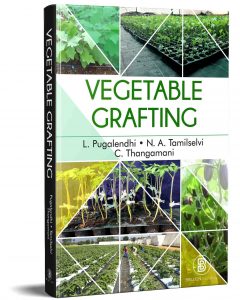Vegetables are nutritionally important and are often referred as ‘Protective food’ and remunerative enough to replace subsistence farming. Grafting in fruit crops is centuries old technique, that has been practiced for many years. However, application of grafting in vegetable crops is a recent innovation for sustainable vegetable production to meet the growing demand. Grafting is a viable technology that revitalizes modern vegetable production in challenging environments. This technique helps for efficient management of soil borne diseases, nematodes and waterlogged soils and helps to the farmers to bring out the quality produce in spite of difficult growing conditions.
Despite a good scope for grafted vegetable production, there is a gap in understanding the grafting techniques, healing methods, graft compatibility, hardening and growing of grafted plants, resistance mechanisms against biotic and abiotic stress factors and duration of grafted plants etc. Consequently the researchers are now being directed to focus on quality organic vegetable production due to high market demand. The book “Vegetable Grafting” has therefore been written for enhancing the knowledge on rootstock species,different grafting techniques, rootstock-scion interactions, physiology of graft union, yield improvement and quality enhancement and increasing the crop duration of grafted plants.
Features of the book:
Efforts has been made to describe the wild species, different grafting methodology, resistance mechanism in solanaceous vegetables (tomato, brinjal, chilli and capsicum), cucurbitaceous vegetables (bitter gourd, cucumber, watermelon) on biotic and abiotic stress factors, growth, yield and quality improvement. Although the benefits of using grafted transplants are now fully recognized worldwide, the need to enlighten the scientific basis of
rootstock–scion interactions under variable environmental pressures remains vital for extracting grafting-mediated crop improvement.
Each chapter of the book is dealt through species description with good quality photographs, illustration of grafting methods, healing, hardening of grafted plants, field establishment and performance of grafted plants,
influence of biotic and abiotic stresses and yield improvement by the extended duration and resistance nature.
Further, it fits well into the organic and integrated crop management system.Hence, a book has been written considering the above points to meet out the insistent need of students and researchers.
Introduction
Grafting methods
Basic requirements for grafted plants production
Grafting techniques in brinjal (Solanum melongena L.)
Grafting techniques in tomato (Solanum lycopersicum L.)
Grafting techniques in capsicum (Capsicum annuum L.)
Grafting techniques in bitter gourd (Momordica charantia L.)
Grafting techniques in cucumber (Cucumis sativus. L.)
Grafting techniques in watermelon [Citrullus lanatus (Thunb.) Matsum. and Nakai]
Mechanization in grafting of vegetables and future prospects


